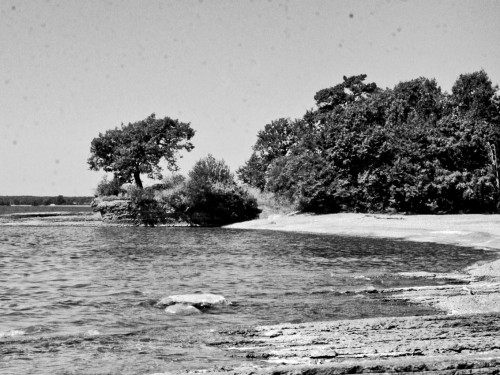County News
Twin oaks


Leon McConnell points out one of the surviving gravestones from the mysterious sailors buried at Point Petre.
An update to the story of the seven sailors whose bodies washed up on Point Petre in 1899
Last week we told you the story of seven sailors whose bodies washed up on the shores near Point Petre and were subsequently buried nearby by the lighthouse keeper. After the story ran, the Times heard from reader Leon McConnell who called to tell us he knew exactly where the bodies came ashore—more surprising still, he knows where the bodies were buried.
It was late in the year—though there seems some doubt that it was December as described in the earlier Times account— when the Point Petre lighthouse keeper made a grisly discovery. In a small cove just a few hundred yards south of the point, Mr. Lowry—his first name is now forgotten— came upon seven bodies that had washed up on shore. None had identification or telltale marks.
The year was 1899 and Point Petre was a remote outpost with few communication or transportation options—little connection to the outside world at all.
With few other options, Lowry turned for help to neighbouring farmers John Wesley and Henry McConnell. The McConnell family had settled and farmed much of the land in this part of the County since their Irish ancestors landed in Gull Pond some 75 years earlier. The McConnells regularly helped and looked out for the lighthouse keeper.
With the help of the McConnell brothers Lowry managed to haul the bodies inland about 200 yards, to the base of a pair of oak trees. There they buried the seven woe-begotten sailors and the story of their tragic end was surely buried with them.
Once they were in the ground, Lowry and the McConnell brothers pried loose seven slabs of limestone to serve as headstones.
At some point later on, a simple wooden cross crafted from roughly hewn timbers was erected in a mortar compound. That original cross is gone now, but has been replaced by a simple two-by-four substitute.
The story of the wayward sailors was told to Leon McConnell by his grandfather John Henry McConnell. His father John Wesley McConnell was one of the brothers who helped bury the bodies.
Leon explains that when his grandfather told him the story, he offered to bring him to the site of the graves—an offer he made good on. The story has left an indelible mark on the Milford resident.
Leon makes no missteps or wrong turns as he leads the way first to the cove in which the bodies landed, and then through thick brush to the pair of massive oak trees that serve sentry over the lost sailors’ gravesites.
Remarkably, five of the seven crude grave markers remain intact and in place.
Leon figures the seven sailors met their end through foul play.
“The fact that none of them had any identification at all leads me to think this wasn’t an accident,” says McConnell.
But while he is one of just a few people who know where the bodies are buried, Leon knows the truth about what happened out on the lake some 112 years ago will likely never be known.

Comments (0)